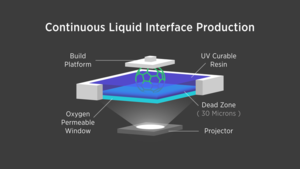Fast 3D Printer inspired by Terminator
Interview with
But first, a revolutionary form of 3D printer inspired by the Hollywood blockbuster "Terminator 2" has been developed by researchers at the University of North Carolina and the company Carbon3D. Rather than painstakingly adding details a layer at a time, which is the conventional approach,  the new system, called CLIP, uses UV light to project a movie into a bath of liquid material; the UV causes the material to solidify rapidly into the desired shape. Georgia Mills spoke with co-inventor Joseph DeSimone...
the new system, called CLIP, uses UV light to project a movie into a bath of liquid material; the UV causes the material to solidify rapidly into the desired shape. Georgia Mills spoke with co-inventor Joseph DeSimone...
Joseph - We were inspired by the scene out of the Terminator 2 movie with a T-1000 arising out of a liquid puddle. And so, we thought, "Why couldn't we get a 3D printer to operate in a manner suggestive of what Hollywood inspired us to think about?" and so, the idea of, could we have a complex 3-dimensional object arise out of the puddle - continuously - and do it rapidly with essentially no waste to make a great object?
Georgia - You mentioned Terminator 2. I watched the video of this printer. It's fantastic, but the film it made me think of was Mary Poppins when she brings these giant things out of a tiny bag. The layer just rises up slowly and this giant object way bigger comes out of it. It's amazing! So, how does this work?
Joseph - What we're basically doing is we're harnessing both light and oxygen to grow the parts. We have a reservoir that maintains a puddle of liquid resin and underneath that is a special window that's permeable to oxygen and transparent to light. And then we lower a stage into the puddle. It gets very close to the window and then we start playing basically a movie. Underneath the window, we project it and it's done in the ultraviolet region of the spectrum. We'll go through very quickly a range of images, the speed of which is coordinated with the elevator that lifts the object out of the puddle. We basically grow these objects very, very quickly with no layers and that way, we can have some parts that have amazing mechanical properties - they look like injection moulded parts. And so having a part come out of a 3D printer that has the properties to be a final part and do at a game changing speeds really opens up 3D manufacture. Our printing speeds go 25 to 100 times faster than traditional 3D printing. So literally, minutes instead of hours and tens of hours is what's possible with this breakthrough.
Georgia - Is this going to scale up? Can you make very large objects? What about the resolution? Can you make really tiny ones as well with the same method?
Joseph - Yes. So, we think we can. Our first machine is going to be in a sort of intermediate size range and 4 inches by 7 inches. Ultimately, we can make that 4 times bigger. But there's a lot of opportunity when one actually goes smaller. And the feature sizes that are relevant smaller are pretty cool. Because we don't have to do layers and because of the gentleness of our process, it's a really powerful tool for fabricating things from tens of microns to thousands of microns with complex geometries. And so, we think this opens up new sorts of sensor technologies. Think about the accelerometers and our health bands, and our automobiles, all sorts of lab on a chip applications and even new drug delivery technologies that we're very excited about.
Georgia - So, you were turning a liquid into a solid essentially. Is there any way it could be turned back?
Joseph - You've been watching too many Hollywood movies. Yeah, that would be very cool. Right now, our process is only the production of the T-1000. We don't have the ability to have them go away yet. Let's work on that.
- Previous Reprogramming leukaemia
- Next Remembering makes you forget










Comments
Add a comment